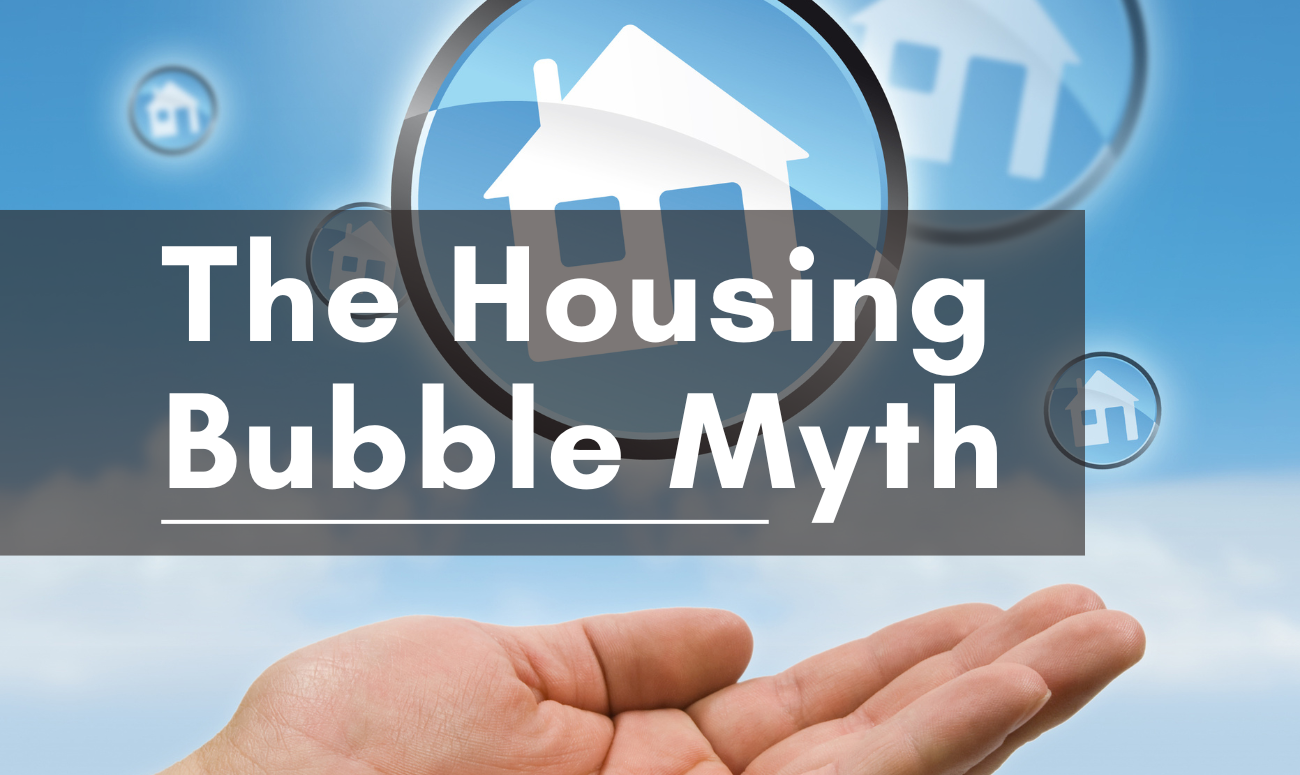The Housing Bubble Myth: The Housing “Bubble” That Wasn’t
Introduction
For years, experts have been predicting an imminent housing market crash. However, despite some cooling in a few overheated areas, prices have continued climbing. Rather than a bubble set to pop, the housing market faces a severe supply shortage that has driven up costs.
The Housing Bubble Myth: Sudden Price Spikes Raised Bubble Concerns
In the past few years, home prices have soared to unprecedented levels. For example, the median Las Vegas home price leapt 50% from pre-pandemic levels to over $420,000. Likewise, costs jumped 70% in Miami and 40% in Boise. Across the country, the typical household now has to spend 34% of its income on ownership expenses like mortgage and taxes — the highest level since the 2008 crash.
Understandably, this rapid appreciation set off bubble alarms. First, these staggering gains enriched early investors and fueled dreams of easy money. Then, speculation ran rampant, with flippers and would-be landlords flaunting mini-empires built on cheap debt. Even sober analysts forecast imminent decline, with some calling for 20%+ price drops in 2023.
The Housing Bubble Myth: The Fed Fanned the Flames
The actions of the Federal Reserve further fanned bubble fears. To combat inflation, the Fed hiked interest rates aggressively starting in 2022. In turn, mortgage rates shot past 7% after languishing around 3% during the pandemic. This not only hampered speculative investing, but also priced many buyers out of the market.
Yet the long-awaited pop never materialized. Despite ballooning rates and retreating demand, home values have remained resilient. The reasons behind this resilience show thatrather than an unsustainable bubble, the housing market suffers from a severe supply shortage.
The Housing Bubble Myth: Lack of Supply, Not Excess Demand
Fundamentally, the runaway home prices stem from a lack of available properties, not a surplus of speculators or unqualified buyers. Simply put, new construction has not kept pace with soaring millennials eager for their slice of the American dream. This mismatch between supply and demand enabled prices to detach from fundamentals.
The Housing Bubble Myth: The Building Shortfall
Over the last decade, homebuilders have struggled to ramp up new construction to meet demand. Several factors created this shortfall:
– Building costs jumped 50% since 2019, largely thanks to pricier materials. This squeezed builder profit margins, deterring projects.
– Construction firms also battled supply chain woes, pandemic-related labor shortages, lot and material constraints. Together, these Issues severely hampered homebuilding rates.
– Regulatory burdens like zoning rules and permitting backlogs likewise stymied construction, especially for entry-level and multifamily housing.
This chronic housing deficit enabled bidding wars and relentless price hikes even as economic fundamentals deteriorated in 2022-2023. Simply put, with millions eager to buy but little new inventory arriving, prices detached from typical drivers like incomes or mortgage rates. Each monthly supply report only strengthened this dynamic.
The Housing Bubble Myth: Limited Foreclosure Risk
Critically, the types of risky lending practices that triggered waves of foreclosures after 2008 are largely absent today. Stricter regulations have kept unqualified buyers out of the market. And record home equity levels give existing owners a vast buffer against distress.
Together, fundamentals like these show why there is no bubble despite rocketing prices. Builders are not oversupplying housing but drastically undersupplying it. And owners are not overleveraged like in 2008 but holding historically high equity stakes. So while the market may normalize, a catastrophic pop is unlikely barring an economic earthquake.
The Housing Bubble Myth: Demand Still Outstrips Supply
Even with mortgage rates remaining elevated, demand is already recovering with generational dynamics that support a healthy housing market. Over the next decade, millennials will continue entering their prime homebuying years, seeking suburban single-family homes as they start families. Additionally, surveys show that nearly a third of Gen Zers still expect to purchase homes in the suburbs.
Despite this ongoing demand pressure, builders face persisting supply-side headaches that will thwart new construction. Lot and material shortages, zoning restrictions, high building costs, and labor challenges remain major obstacles. These constraints mean the market is likely to face a deficit of 5.5 – 7 million homes over the next decade per estimates.
With demand rebounding but supply still lagging, double-digit price corrections seem unfounded. With millions of millennials still hoping to become homeowners, the market may well absorb the coming wave of new listings without a major downward move.
The Housing Bubble Myth: Sure Signs This Time Is Different
The data shows today’s housing landscape is far removed from the feverish speculation of the mid-2000s bubble. Virtually all signs point to sustainable price gains rooted in demographics rather than excessive debt or loose lending standards. Simply put, fundamentals do not support bubble prognostications.
The Housing Bubble Myth: Why A Crash Is Unlikely
Given the resilience so far, many now see sustained strength rather than looming catastrophe. The data shows this time is fundamentally different from 2008. Instead of excess, the market suffers from scarcity, and owners boast rock-solid finances.
The Housing Bubble Myth: Builders Still Can’t Catch Up
Critically, the mismatch between supply and demand persists even with rates elevated. Despite some pullbacks, millennials continue entering peak homebuying years, targeting suburban single-family homes. Simultaneously, builders wrestle with construction barriers like material/labor shortfalls, zoning rules, and inflated building expenses.
These dynamics will sustain a 5-7 million home deficit over the next decade per projections. With demand rebounding but supply still lagging, the ingredients for a crash seem lacking. Instead, the market may absorb forthcoming inventory without a major downward move.
The Housing Bubble Myth: Homeowners Hold Far More Equity
Likewise, homeowners are not financially extended like in 2008. Prudential regulations have kept unqualified buyers out, while owners currently hold tremendous equity buffers against downturns.
Nearly 80% of mortgaged properties carry rates below 5% — an incredible deal historically. Additionally, delinquencies hover near all-time lows, and average credit scores of new borrowers top 770 — quite strong. Finally, almost 40% of owners carry no mortgage whatsoever.
In short, instead of overleverage fueling distress, owners have tremendous loss absorption capacity today. This further lessens risks as the market normalize
The Housing Bubble Myth: Prices Have Stabilized Below Peak Levels
After reaching new highs in mid-2022, home values have cooled slightly but remain elevated. Nationally, prices rose a steady 4% over 2023 despite spiking mortgage rates. Major forecasters like Fannie Mae and Goldman Sachs see similar mid-single digit ascents in 2024 as well.
Certainly, the era of 20-30% yearly gains appears over. But a gradual climb from historically high levels looks more likely than sudden calamity. This lets stretched buyers catch their breath while better matching supply with demand.
The Housing Bubble Myth: What Could Cause a Crash?
Admittedly, projected strength assumes no major economic shocks emerge. An exceptionally severe downturn that spurs prolonged, mass unemployment could overwhelm owner resilience. However, most expect even a recession would prove insufficient to destabilize housing in light of current fundamentals.
Alternatively, if lending dried up comprehensively — as during the financial crisis — values could witness more material drops. But this scenario seems doubtful barring utter industry collapse.
Of course, major geopolitical or public health crises could likewise upend economic stability significantly. Yet these “black swans” defy prediction by their very nature.
Absent such unfathomable events, the data suggests the recent frenzy was grounded more in scarcity than speculation. With supply-demand rebalancing modestly underway, projection models foreshadow stability rather than free-fall.
The Housing Bubble Myth: Silver Linings Loom Ahead
The lack of inventory that enabled runaway price gains appears set to ease somewhat moving forward. Though still undersupplied, new construction should continue ramping up to help cool appreciation levels. This rebalancing is a positive for buyers feeling locked out since 2020.
Additionally, many took advantage of pandemic rates to refinance, leaving them buffered against payment shocks should economic troubles emerge. Owners also built tremendous equity cushions in recent years. This further bolsters market stability if faced with external crises.
Finally, the transition toward sustainability promises greater affordability long-term. Though still elevated, materials costs and supply disruptions have begun easing. Meanwhile remote work opportunities are expanding housing options for those able to take advantage.
Together these trends hint at a healthier direction, even if plentiful affordable inventory remains years away for many regions. The crisis stage likely passed; now sustainability and balance can become the focus.
The Housing Bubble Myth: Bubble or Not, Challenges Loom
While a sudden crash seems unlikely, owning a home still remains out of reach for many, especially first-time buyers. Prices may descend from peak levels but are still extremely elevated historically. And mortgage rates are double their pandemic lows even after retreating, further eroding affordability.
Making matters worse, rents and broader inflation also cut into potential savings needed for a down payment. Additionally, builders contend with lingering supply-chain issues, worker shortages, and rising building costs. Together, these headwinds will continue constraining desperately needed construction, sustaining scarcity.
The Housing Bubble Myth: Policy Actions Could Help Ease the Crunch
Government policies may hold the key to balancing housing markets long-term. Zoning reform and streamlining construction approvals would enable more building. Additionally, first-time buyer programs, affordable housing investments, and middle-density housing policies could expand access.
Creative solutions like converting vacant offices into condos or updating infrastructure to support new residents also show promise in supply-starved regions. Though not silver bullets, coordinated efforts across federal, state and local governing bodies may help bridge the shortage over time.
The Housing Bubble Myth: A Healthier Trajectory Takes Shape
In total, current dynamics seem to foreshadow stabilization rather than volatility. The days of 20-30% annual price leaps have likely passed. But a slight balancing of demand and supply could prevent the devastating pullback some still envision.
With millennials aging into homeownership and builder constraints persisting, the market may settle into more modest but still healthy appreciation cycles. Of course, many can’t afford to wait years for sufficient inventory. Though no longer overheating, housing still demands dedicated policy efforts to ensure broader access.
The bubble watchers can stand down; now the real work begins. With speculation receding and resilience emerging, leaders must pivot focus to the systemic shortfalls, not temporary excess, underlying the ongoing affordability crisis.
The Housing Bubble Myth: Conclusion
In the end, the long-awaited housing bubble burst never materialized, despite persistent warnings. Rapid price appreciation and speculative excess initially showed hallmarks of impending crisis. However, a deeper analysis reveals sustainable drivers more akin to shortage than excess.
Demand remains strong thanks to favorable demographics, while supply continues hampered by construction obstacles. Additionally, current owners boast healthy finances unlike 2008, with low rates, sky-high credit, and tremendous equity buffers.
Absent an unfathomable economic shock, indicators suggest the market likely transitions toward more moderate but still solid appreciation going forward. The supply-demand imbalance shows some signs of improving, though not nearly enough for most buyers.
While a devastating correction seems improbable, affordability and access challenges will persist for years absent concerted policy efforts. The bubble mania made for flashy headlines but distracted from the systemic undersupply fueling the price surge.
With resilience emerging from the frenzy, the focus must shift to reforms that promote sustainability and equity. Only by confronting the true structural catalysts rather than transient excess can leaders facilitate broader stability and ownership.
The bubble is conclusively burst…because it never inflated in the first place. Now comes the real work.
If you are looking for Real Estate Companies St Petersburg Fl visit https://avalongrouptampabay.com/




